HOME |
|
| • | Introduction |
| • | Family and Friends |
| • | Highlands |
| • | Melaka |
| • | Fieldwork |
| • | Nepenthes |
| BRITAIN | |
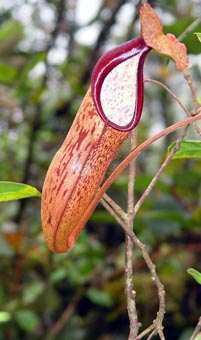 |
This is a typical Nepenthes. It is a good specimen too, the lip is constantly a nice shade of red and the rest of the body is undamaged. Now that you know what a usual pitcher looks like, you will be able to see the differences in some of the others we photographed. Note that this is only one species of Nepenthes. We found at least three different types up in the Cameron Highlands, where all these photographs were taken. We did find one plant in Frasers Hill but all the pitchers were dead. |
| This strange species was found on a slope on the way up to the actual walk. It is red all over excluding the inseide of the pitcher and at the front of the rim are six thin "whiskers". They may be there as bait to atract insects. But it does look very nice. If you want to see a close up of the "whiskers" (click here). It isn't a very clear photo but it was hard to take from downhill. This one's "whiskers" may just be its spiky wing sticking up. | 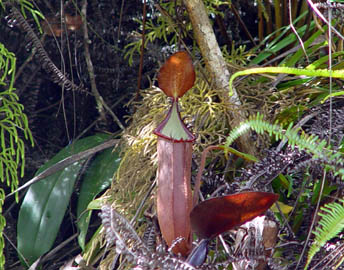 |
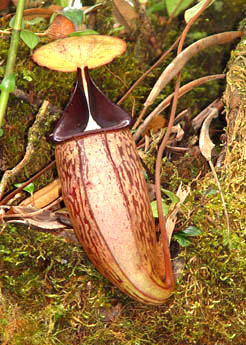 |
This Nepenthes has an unusually large rim, or peristome, to be precise. It is also a lot darker than any other of its species we had seen. It has a large pitcher and nice full colouring. There isn't much else to say about this nepenthes except that the peristome was surprisingly large |
|
|
| These are the white Nepenthes. We tried very hard to get good pictures of these ones because we didn't know why they were white like this. (They also looked very pretty). We figured it might be because of the sun, because they were only growing in the tree tops, or they may just have been another species. In the end we managed to get some good pictures of them and they are further down the page. You may notice that the bottoms of the pitchers are still fading in light green. This also points to the fact theat this white colouration may come from the sun. | |
| This one was sitting by itself in the ground, and it looked like it may have just opened. Notice how the lid curves downwards instead of upwards. This one is like an umbrella as where others are like inside-out umbrellas. I also think this one has a good side-on view and looks more impresive than if it was facing forwards. |  |
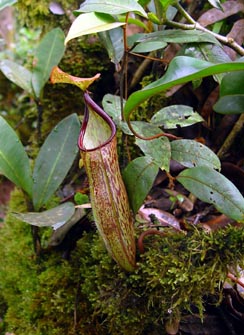 |
This pitcher is a bit like the first one, except it has a much darker peristome and it is longer and thinner. It is another typical example and the first description covers the rest of what this one is like. |
 |
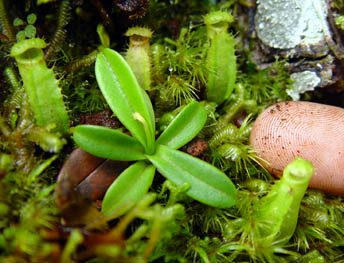 |
| Now these fascinating ones look a tiny (I mean tiny) bit like Cephalotus, the West Australian pitcher plant.The only differences are that they are taller and that their tendrils attach at the bottom of the pitchers. These must catch extremely small invertabrets for prey because they are only about half to one and a half centimetres tall. If they were a different species or if they were just very young plants is still a mystery to me. Since they are so small it is very hard to identify them. We only found them at the begining of the track. Maybe we just weren't looking but we certainly didn't see them anywhere else. The picture on the left is a magnified version of the picture onthe right and the place just above and left of my finger. | |
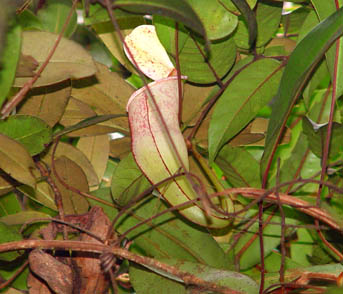 |
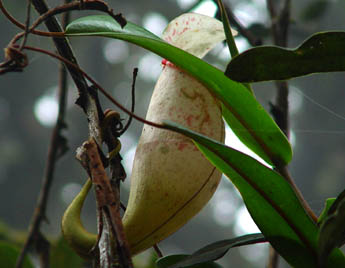 |
 |
The top left, above and the picture on the left, all have their desciptions here. These are the good close-ups that I was talking about five pictures before. The pitcher on the top left has a good contrast to the leaves in the background and stands out a lot more. The picture above is very fat in comparison to the other white pitchers. Unfortunately one of it's leaves got inthe way of the mouth. The specimen on the left, unfortunately, had died and fallen to the ground. I sat it up against some moss mounds and took the photo. It is probably the best photo of a white Nepenthes we have here, even if it was dead. You can see the pinkish peristome where the red had faded away to some degree before it deid. |
| Thsi speciman is, I think, also
the same species as the one with the "whiskers" and they
were also both found right next to each other and this one does
not have any whiskers. |
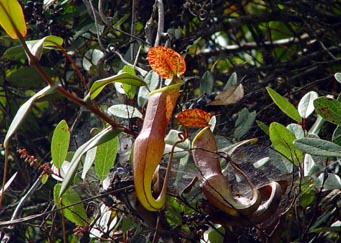
|
 |
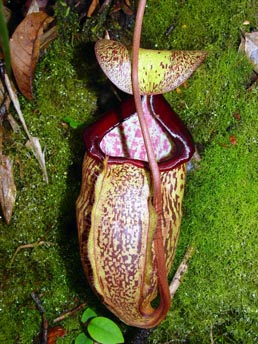 |
| I have done some research and going on some pictures and a description of where they grow I have come to the conclusion that they are the Nepenthes x. macfarlanei. The picture above is an unopened pitcher that has certainly grown alot because it was a tiny bit bigger than the specimen in the picture below. On the pitcher on the left the beautiful red mottling is very distinct and you are able to get the full value of how nice they look. Abother thing that is so wonderful about moss forests is that they have tons of (guess what) moss. Some of it has very long stems while others have a more sponge-like appearance. Certain types of moss are so spong that they can hold vast amounts of water for fairly long periods, thus making it an ideal place for Nepenthes to grow. |
|
 |
This about as big as most of the pitchers were
and some, such as the one above and left, were bigger and some such
as the one below were smaller. It may look like I am distorting
the pitcher a bit in this picture but I asure you that is is quite
fine and was growing in a fairly curvy way when we found it. I think
that this cup is the same one as the picture above but I am not
entirely sure. As I said some of them were bigger than this one
and I could certainly fit my hand pretty comfortably in one of them.
|
| Thsi one was hiding in a small hole in the five inch thick wall of moss on all of the trees. You can not see it so well now as I used the flash and some of the shadowing has gone, but when I saw it it looked very cute hiding there amongst all of the moss. It was only about ten centimetres tall and it's hood is slightly bent as you can see. |
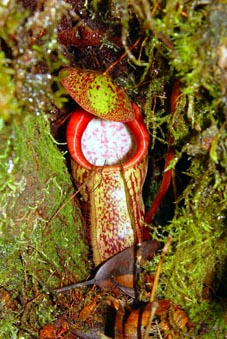 |
 |
This one is a pretty good photo because you can
see the diference between the two stages of growth in the pitchers.
When it is young the spots are red but as it grows older there comes
to be less green so there are more green spots. The smaller one
really does look like some kind of teapot. |
 |
 |
|
These are some very graceful Nepenthes from University
Malaya we found on a man-made big hill there were tons of the! The
biggest, which were about 12 cm, are shown in these photos. They
are a very nice green colour and have a little ridge about three
quaters of the way down. I think it is Nepenthes gracilis. |
|
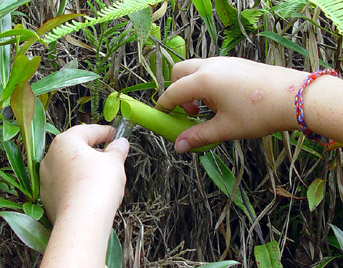 |
Here I am collecting the juices from the pitcher to examinewhat kind of insects they catch and how much water they get. I still have not properly done this under a microscope. |

